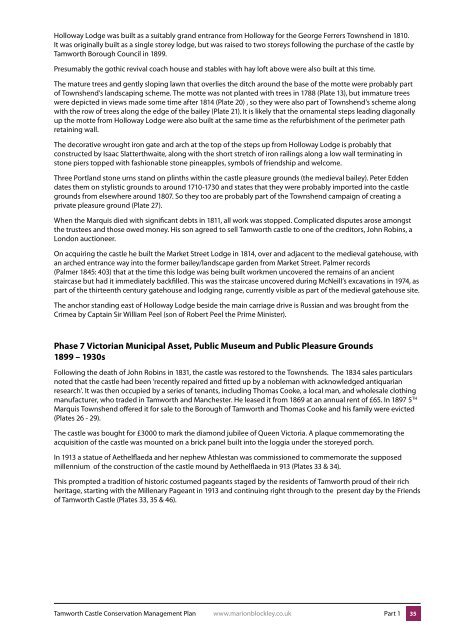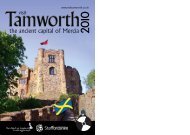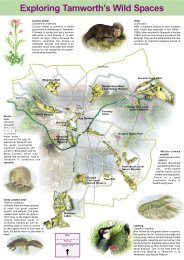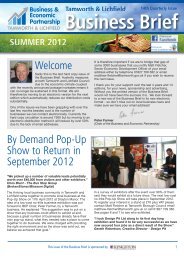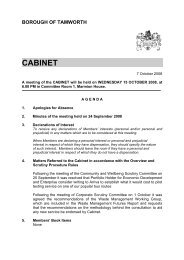Conservation Management Plan - Tamworth Borough Council
Conservation Management Plan - Tamworth Borough Council
Conservation Management Plan - Tamworth Borough Council
Create successful ePaper yourself
Turn your PDF publications into a flip-book with our unique Google optimized e-Paper software.
Holloway Lodge was built as a suitably grand entrance from Holloway for the George Ferrers Townshend in 1810.<br />
It was originally built as a single storey lodge, but was raised to two storeys following the purchase of the castle by<br />
<strong>Tamworth</strong> <strong>Borough</strong> <strong>Council</strong> in 1899.<br />
Presumably the gothic revival coach house and stables with hay loft above were also built at this time.<br />
The mature trees and gently sloping lawn that overlies the ditch around the base of the motte were probably part<br />
of Townshend’s landscaping scheme. The motte was not planted with trees in 1788 (Plate 13), but immature trees<br />
were depicted in views made some time after 1814 (Plate 20) , so they were also part of Townshend’s scheme along<br />
with the row of trees along the edge of the bailey (Plate 21). It is likely that the ornamental steps leading diagonally<br />
up the motte from Holloway Lodge were also built at the same time as the refurbishment of the perimeter path<br />
retaining wall.<br />
The decorative wrought iron gate and arch at the top of the steps up from Holloway Lodge is probably that<br />
constructed by Isaac Slatterthwaite, along with the short stretch of iron railings along a low wall terminating in<br />
stone piers topped with fashionable stone pineapples, symbols of friendship and welcome.<br />
Three Portland stone urns stand on plinths within the castle pleasure grounds (the medieval bailey). Peter Edden<br />
dates them on stylistic grounds to around 1710-1730 and states that they were probably imported into the castle<br />
grounds from elsewhere around 1807. So they too are probably part of the Townshend campaign of creating a<br />
private pleasure ground (Plate 27).<br />
When the Marquis died with significant debts in 1811, all work was stopped. Complicated disputes arose amongst<br />
the trustees and those owed money. His son agreed to sell <strong>Tamworth</strong> castle to one of the creditors, John Robins, a<br />
London auctioneer.<br />
On acquiring the castle he built the Market Street Lodge in 1814, over and adjacent to the medieval gatehouse, with<br />
an arched entrance way into the former bailey/landscape garden from Market Street. Palmer records<br />
(Palmer 1845: 403) that at the time this lodge was being built workmen uncovered the remains of an ancient<br />
staircase but had it immediately backfilled. This was the staircase uncovered during McNeill’s excavations in 1974, as<br />
part of the thirteenth century gatehouse and lodging range, currently visible as part of the medieval gatehouse site.<br />
The anchor standing east of Holloway Lodge beside the main carriage drive is Russian and was brought from the<br />
Crimea by Captain Sir William Peel (son of Robert Peel the Prime Minister).<br />
Phase 7 Victorian Municipal Asset, Public Museum and Public Pleasure Grounds<br />
1899 – 1930s<br />
Following the death of John Robins in 1831, the castle was restored to the Townshends. The 1834 sales particulars<br />
noted that the castle had been ‘recently repaired and fitted up by a nobleman with acknowledged antiquarian<br />
research’. It was then occupied by a series of tenants, including Thomas Cooke, a local man, and wholesale clothing<br />
manufacturer, who traded in <strong>Tamworth</strong> and Manchester. He leased it from 1869 at an annual rent of £65. In 1897 5 TH<br />
Marquis Townshend offered it for sale to the <strong>Borough</strong> of <strong>Tamworth</strong> and Thomas Cooke and his family were evicted<br />
(Plates 26 - 29).<br />
The castle was bought for £3000 to mark the diamond jubilee of Queen Victoria. A plaque commemorating the<br />
acquisition of the castle was mounted on a brick panel built into the loggia under the storeyed porch.<br />
In 1913 a statue of Aethelflaeda and her nephew Athlestan was commissioned to commemorate the supposed<br />
millennium of the construction of the castle mound by Aethelflaeda in 913 (Plates 33 & 34).<br />
This prompted a tradition of historic costumed pageants staged by the residents of <strong>Tamworth</strong> proud of their rich<br />
heritage, starting with the Millenary Pageant in 1913 and continuing right through to the present day by the Friends<br />
of <strong>Tamworth</strong> Castle (Plates 33, 35 & 46).<br />
<strong>Tamworth</strong> Castle <strong>Conservation</strong> <strong>Management</strong> <strong>Plan</strong> www.marionblockley.co.uk<br />
Part 1<br />
35


